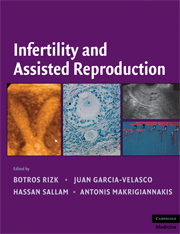Book contents
- Frontmatter
- Contents
- Contributors
- Foreword
- Preface
- Introduction
- PART I PHYSIOLOGY OF REPRODUCTION
- PART II INFERTILITY EVALUATION AND TREATMENT
- 6 Evaluation of the Infertile Female
- 7 Fertiloscopy
- 8 Microlaparoscopy
- 9 Pediatric and Adolescent Gynecologic Laparoscopy
- 10 Laparoscopic Tubal Anastomosis
- 11 Tubal Microsurgery versus Assisted Reproduction
- 12 The Future of Operative Laparoscopy for Infertility
- 13 Operative Hysteroscopy for Uterine Septum
- 14 Laser in Subfertility
- 15 Ultrasonography of the Endometrium for Infertility
- 16 Ultrasonography of the Cervix
- 17 Transrectal Ultrasonography in Male Infertility
- 18 The Basic Semen Analysis: Interpretation and Clinical Application
- 19 Evaluation of Sperm Damage: Beyond the WHO Criteria
- 20 Male Factor Infertility: State of the ART
- 21 Diagnosis and Treatment of Male Ejaculatory Dysfunction
- 22 Ovulation Induction
- 23 Clomiphene Citrate for Ovulation Induction
- 24 Aromatase Inhibitors for Assisted Reproduction
- 25 Pharmacodynamics and Pharmacokinetics of Gonadotrophins
- 26 The Future of Gonadotrophins: Is There Room for Improvement?
- 27 Ovarian Hyperstimulation Syndrome
- 28 Reducing the Risk of High-Order Multiple Pregnancy Due to Ovulation Induction
- 29 Hyperprolactinemia
- 30 Medical Management of Polycystic Ovary Syndrome
- 31 Surgical Management of Polycystic Ovary Syndrome
- 32 Endometriosis-Associated Infertility
- 33 Medical Management of Endometriosis
- 34 Reproductive Surgery for Endometriosis-Associated Infertility
- 35 Congenital Uterine Malformations and Reproduction
- 36 Unexplained Infertility
- 37 “Premature Ovarian Failure”: Characteristics, Diagnosis, and Management
- PART III ASSISTED REPRODUCTION
- PART IV ETHICAL DILEMMAS IN FERTILITY AND ASSISTED REPRODUCTION
- Index
- Plate section
- References
35 - Congenital Uterine Malformations and Reproduction
from PART II - INFERTILITY EVALUATION AND TREATMENT
Published online by Cambridge University Press: 04 August 2010
- Frontmatter
- Contents
- Contributors
- Foreword
- Preface
- Introduction
- PART I PHYSIOLOGY OF REPRODUCTION
- PART II INFERTILITY EVALUATION AND TREATMENT
- 6 Evaluation of the Infertile Female
- 7 Fertiloscopy
- 8 Microlaparoscopy
- 9 Pediatric and Adolescent Gynecologic Laparoscopy
- 10 Laparoscopic Tubal Anastomosis
- 11 Tubal Microsurgery versus Assisted Reproduction
- 12 The Future of Operative Laparoscopy for Infertility
- 13 Operative Hysteroscopy for Uterine Septum
- 14 Laser in Subfertility
- 15 Ultrasonography of the Endometrium for Infertility
- 16 Ultrasonography of the Cervix
- 17 Transrectal Ultrasonography in Male Infertility
- 18 The Basic Semen Analysis: Interpretation and Clinical Application
- 19 Evaluation of Sperm Damage: Beyond the WHO Criteria
- 20 Male Factor Infertility: State of the ART
- 21 Diagnosis and Treatment of Male Ejaculatory Dysfunction
- 22 Ovulation Induction
- 23 Clomiphene Citrate for Ovulation Induction
- 24 Aromatase Inhibitors for Assisted Reproduction
- 25 Pharmacodynamics and Pharmacokinetics of Gonadotrophins
- 26 The Future of Gonadotrophins: Is There Room for Improvement?
- 27 Ovarian Hyperstimulation Syndrome
- 28 Reducing the Risk of High-Order Multiple Pregnancy Due to Ovulation Induction
- 29 Hyperprolactinemia
- 30 Medical Management of Polycystic Ovary Syndrome
- 31 Surgical Management of Polycystic Ovary Syndrome
- 32 Endometriosis-Associated Infertility
- 33 Medical Management of Endometriosis
- 34 Reproductive Surgery for Endometriosis-Associated Infertility
- 35 Congenital Uterine Malformations and Reproduction
- 36 Unexplained Infertility
- 37 “Premature Ovarian Failure”: Characteristics, Diagnosis, and Management
- PART III ASSISTED REPRODUCTION
- PART IV ETHICAL DILEMMAS IN FERTILITY AND ASSISTED REPRODUCTION
- Index
- Plate section
- References
Summary
The genital tract in the female arises from two embryonic sources, the Mullerian ducts (mesodermal in origin) and the urogenital sinus (endodermal in origin). Abnormal Mullerian differentiation is frequently associated with urologic malformations.
EMBRYOLOGY
The Mullerian (paramesonephric) ducts appear in the 10-mm crown-rump length embryo (about five weeks) by an invagination of the coelomic epithelium into the underlying mesenchyme lateral to the cranial extremity of the Wolffian ducts (Figure 35.1).
In the female, the site of invagination becomes the future abdominal opening of the Fallopian tube. At the caudal tip of this invagination, a solid bud is formed, which burrows in the mesenchyme lateral to and parallel with the Wolffian ducts. At the caudal extremity of the mesonephros, the Mullerian duct crosses ventrally and medially and grows mediocaudally to meet and fuse with the duct of the opposite side (Figure 35.2). Fusion of the Mullerian ducts is at first incomplete, so that for a short while a septum separates their two cavities. In embryos about 56 mm long (about twelve weeks), the septum degenerates and gives a single cavity, the uterovaginal (genital) canal. The caudal tip of this canal comes in contact with the dorsal wall of the urogenital sinus, producing an elevation, the Mullerian tubercle (Figure 35.3). Proliferation of the tip of the uterovaginal canal results in the formation of a solid vaginal cord.
Keywords
- Type
- Chapter
- Information
- Infertility and Assisted Reproduction , pp. 327 - 331Publisher: Cambridge University PressPrint publication year: 2008
References
- 2
- Cited by



